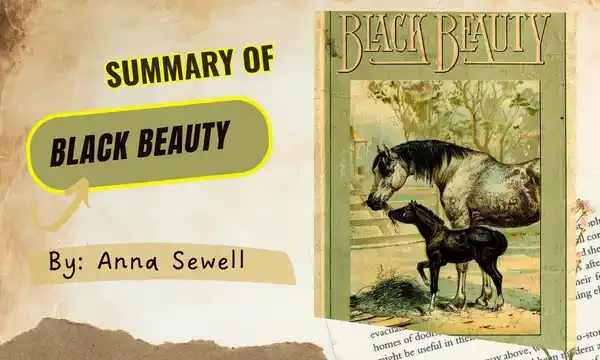Black Beauty by Anna Sewell is a classic novel that aims to promote empathy and understanding towards horses, while also criticizing the mistreatment of animals. It explores the experiences and perspectives of a horse named Black Beauty as he encounters various owners and witnesses both kindness and cruelty in Victorian England.
 |
| Summary of Black Beauty by Anna Sewell |
The general idea of the book Black Beauty
Kindness and empathy towards animals: The book emphasizes the importance of treating animals with compassion and respect, highlighting the positive impact it can have on their well-being
Black Beauty's interactions with kind and understanding owners demonstrate the positive effects of humane treatment.
Sewell argues that humans have a responsibility to care for and protect animals, emphasizing the reciprocal nature of the human-animal relationship.
Critique of animal mistreatment: Sewell uses Black Beauty's experiences to shed light on the harsh realities and abuse suffered by horses in Victorian society.
The novel exposes the cruelty of certain horse-keeping practices, such as the use of severe bits, overworking, and neglect.
Sewell encourages readers to reflect on their treatment of animals and advocate for their welfare.
Black Beauty book chapters
My Early Home: Black Beauty recounts his upbringing on a pleasant farm, developing a deep bond with his mother and learning valuable lessons about trust and kindness from his early experiences.
A Removal: Black Beauty is sold and moves to a new home, where he experiences both good and bad treatment from his various owners. This chapter sets the stage for the overarching theme of the novel, highlighting the diverse range of human behavior towards animals.
The Lady Anne, or a Runaway Horse: Black Beauty becomes a carriage horse and has a dangerous encounter with a runaway horse named Ginger, leading to a discussion on the mistreatment of horses and the use of check-reins.
Ginger: Black Beauty's friendship with Ginger grows as they endure similar mistreatment. The chapter focuses on the plight of working horses, their harsh living conditions, and the effects of poor treatment on their physical and mental well-being.
Merrylegs: Black Beauty meets Merrylegs, a lively and well-cared-for pony, demonstrating the stark contrast between good and bad ownership. This chapter highlights the positive impact of kind and understanding owners on horses' lives.
The Old Hostler: Black Beauty's former hostler, James, teaches him about the importance of good horsemanship and the responsibilities of horse owners. The chapter emphasizes the value of knowledgeable and compassionate caretakers.
Black Beauty Book Conclusions
The mistreatment of animals, specifically horses, is a prevalent issue that demands attention and reform.
Demonstrating kindness and empathy towards animals is crucial for their well-being.
Responsible horse ownership involves proper care, humane treatment, and understanding the needs of these animals.
About the author of the book Black Beauty
Anna Sewell (1820-1878) was an English novelist born in Norfolk, England. Despite suffering from a chronic illness that limited her mobility, Sewell had a deep love for horses and a passion for animal welfare. "Black Beauty" was her only published novel, written during the last years of her life. Sewell's personal experiences and her belief in the power of storytelling to effect change informed her writing.
Read more:
Summary of Ulysses by James Joyce
Summary of Mrs. Dalloway by Virginia Woolf
Black Beauty book in relation to other books
"Black Beauty" stands as a pioneering work in the genre of animal literature. Its narrative from the perspective of a horse and its focus on advocating for the humane treatment of animals set it apart from other books of its time. The novel has been influential in inspiring subsequent works in the genre, such as "The Call of the Wild" by Jack London and "Watership Down" by Richard Adams.
Black Beauty book audience
The intended audience for "Black Beauty" is both children and adults. The book's accessible language and engaging storytelling make it suitable for younger readers, while its thematic depth and social commentary resonate with adult readers as well. The novel's aim to promote empathy and understanding towards animals appeals to readers of all ages.
Black Beauty book publication date
"Black Beauty" was first published by Jarrold & Sons in 1877.
Recommendations for other books
"The Call of the Wild" by Jack London: This classic novel explores the journey of a dog named Buck as he navigates the harsh realities of the Klondike Gold Rush, providing insight into the human-animal bond and the resilience of animals.
"Watership Down" by Richard Adams: This epic adventure follows a group of rabbits as they search for a new home, delving into themes of survival, leadership, and the relationship between humans and nature.
